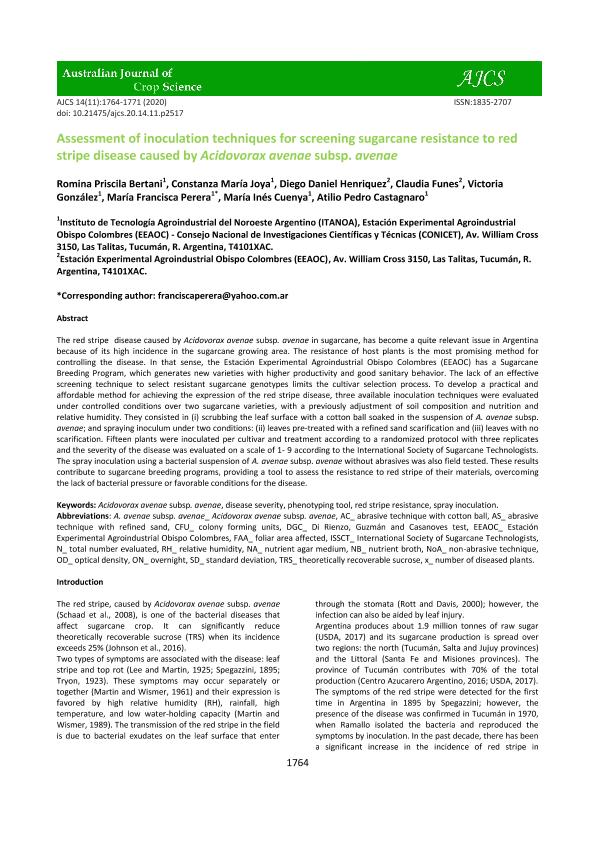Mostrar el registro sencillo del ítem
dc.contributor.author
Bertani, Romina Priscila

dc.contributor.author
Joya, Constanza María

dc.contributor.author
Henriquez, Diego Daniel

dc.contributor.author
Funes, Claudia

dc.contributor.author
González, Victoria
dc.contributor.author
Perera, María Francisca

dc.contributor.author
Cuenya, María Inés

dc.contributor.author
Castagnaro, Atilio Pedro

dc.date.available
2021-11-17T19:53:16Z
dc.date.issued
2020-02
dc.identifier.citation
Bertani, Romina Priscila; Joya, Constanza María; Henriquez, Diego Daniel; Funes, Claudia; González, Victoria; et al.; Assessment of inoculation techniques for screening sugarcane resistance to red stripe disease caused by Acidovorax avenae subsp. avenae; Southern Cross Publishing; Australian Journal of Crop Science; 14; 11; 2-2020; 1764-1771
dc.identifier.issn
1835-2693
dc.identifier.uri
http://hdl.handle.net/11336/147093
dc.description.abstract
The red stripe disease caused by Acidovorax avenae subsp. avenae in sugarcane, has become a quite relevant issue in Argentina because of its high incidence in the sugarcane growing area. The resistance of host plants is the most promising method for controlling the disease. In that sense, the Estación Experimental Agroindustrial Obispo Colombres (EEAOC) has a Sugarcane Breeding Program, which generates new varieties with higher productivity and good sanitary behavior. The lack of an effective screening technique to select resistant sugarcane genotypes limits the cultivar selection process. To develop a practical and affordable method for achieving the expression of the red stripe disease, three available inoculation techniques were evaluated under controlled conditions over two sugarcane varieties, with a previously adjustment of soil composition and nutrition and relative humidity. They consisted in (i) scrubbing the leaf surface with a cotton ball soaked in the suspension of A. avenae subsp. avenae; and spraying inoculum under two conditions: (ii) leaves pre-treated with a refined sand scarification and (iii) leaves with no scarification. Fifteen plants were inoculated per cultivar and treatment according to a randomized protocol with three replicates and the severity of the disease was evaluated on a scale of 1- 9 according to the International Society of Sugarcane Technologists. The spray inoculation using a bacterial suspension of A. avenae subsp. avenae without abrasives was also field tested. These results contribute to sugarcane breeding programs, providing a tool to assess the resistance to red stripe of their materials, overcoming the lack of bacterial pressure or favorable conditions for the disease.
dc.format
application/pdf
dc.language.iso
eng
dc.publisher
Southern Cross Publishing

dc.rights
info:eu-repo/semantics/openAccess
dc.rights.uri
https://creativecommons.org/licenses/by-nc-sa/2.5/ar/
dc.subject
ACIDOVORAX AVENAE SUBSP. AVENAE
dc.subject
DISEASE SEVERITY
dc.subject
PHENOTYPING TOOL
dc.subject
RED STRIPE RESISTANCE
dc.subject
SPRAY INOCULATION
dc.subject.classification
Biotecnología Agrícola y Biotecnología Alimentaria

dc.subject.classification
Biotecnología Agropecuaria

dc.subject.classification
CIENCIAS AGRÍCOLAS

dc.title
Assessment of inoculation techniques for screening sugarcane resistance to red stripe disease caused by Acidovorax avenae subsp. avenae
dc.type
info:eu-repo/semantics/article
dc.type
info:ar-repo/semantics/artículo
dc.type
info:eu-repo/semantics/publishedVersion
dc.date.updated
2021-04-28T21:01:45Z
dc.identifier.eissn
1835-2707
dc.journal.volume
14
dc.journal.number
11
dc.journal.pagination
1764-1771
dc.journal.pais
Australia

dc.description.fil
Fil: Bertani, Romina Priscila. Consejo Nacional de Investigaciones Científicas y Técnicas; Argentina. Gobierno de Tucumán. Ministerio de Desarrollo Productivo. Estación Experimental Agroindustrial Obispo Colombres; Argentina
dc.description.fil
Fil: Joya, Constanza María. Consejo Nacional de Investigaciones Científicas y Técnicas; Argentina. Gobierno de Tucumán. Ministerio de Desarrollo Productivo. Estación Experimental Agroindustrial Obispo Colombres; Argentina
dc.description.fil
Fil: Henriquez, Diego Daniel. Gobierno de Tucumán. Ministerio de Desarrollo Productivo. Estación Experimental Agroindustrial Obispo Colombres; Argentina
dc.description.fil
Fil: Funes, Claudia. Gobierno de Tucumán. Ministerio de Desarrollo Productivo. Estación Experimental Agroindustrial Obispo Colombres; Argentina
dc.description.fil
Fil: González, Victoria. Gobierno de Tucumán. Ministerio de Desarrollo Productivo. Estación Experimental Agroindustrial Obispo Colombres; Argentina
dc.description.fil
Fil: Perera, María Francisca. Consejo Nacional de Investigaciones Científicas y Técnicas; Argentina. Gobierno de Tucumán. Ministerio de Desarrollo Productivo. Estación Experimental Agroindustrial Obispo Colombres; Argentina
dc.description.fil
Fil: Cuenya, María Inés. Consejo Nacional de Investigaciones Científicas y Técnicas; Argentina. Gobierno de Tucumán. Ministerio de Desarrollo Productivo. Estación Experimental Agroindustrial Obispo Colombres; Argentina
dc.description.fil
Fil: Castagnaro, Atilio Pedro. Consejo Nacional de Investigaciones Científicas y Técnicas; Argentina. Gobierno de Tucumán. Ministerio de Desarrollo Productivo. Estación Experimental Agroindustrial Obispo Colombres; Argentina
dc.journal.title
Australian Journal of Crop Science

dc.relation.alternativeid
info:eu-repo/semantics/altIdentifier/doi/http://dx.doi.org/10.21475/ajcs.20.14.11.p2517
dc.relation.alternativeid
info:eu-repo/semantics/altIdentifier/url/https://www.cropj.com/bertani_14_11_2020_1764_1771.pdf
Archivos asociados
